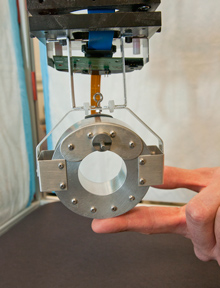 |
| Wearable PET: A rat’s head fits in the circular opening of this device, which is surrounded by miniaturized detectors and electronics. Credit: Brookhaven National Laboratory |
A tiny wearable scanner has been used to track chemical activity in the brains of unrestrained animals for the first time. By revealing neurological circuitry as the subjects perform normal tasks, researchers say, the technology could greatly broaden the understanding of learning, addiction, depression, and other conditions.
The device was designed to be used with rats—the main animal model used by behavioral neuroscientists. But the researchers who developed the device, at Brookhaven National Laboratory, say it would be straightforward to engineer a similar device for people.
Positron emission tomography, or PET, is already broadly used in neuroscience research and in clinical treatment. It allows researchers to track the location of radioactively labeled neurotransmitters (the chemicals that carry signals between neurons) or drugs within the brain. Images of the way neurotransmitters and drugs move through the brain can reveal the processes that underpin normal behavior such as learning as well as pathologies including addiction. PET has been used to map drug-binding sites in the brains of addicts and healthy people, and to study how those sites change over time and with therapy.
A conventional PET scanner is so large that these studies have to be performed with the subject lying inside a large tube. Large photomultiplier tubes amplify signals from gamma rays emitted by labeled chemicals in the brain. The signals then pass through a desk-sized rack of electronics that process them and map them to a particular region of the brain. To get good readings during animal studies, the subjects are typically anaesthetized or restrained. What's being measured is not normal waking behavior.
"We have very limited data about what brains do in the real world," says Paul Glimcher, professor of neuroscience, economics, and psychology at New York University. Glimcher was not involved with the work.
The new portable scanner is designed to provide the same information about brain chemistry while an animal behaves naturally. It is small and lightweight enough that a rat can carry it around on its head. "[The rat] can move freely, interact with other animals, and at the same time we can make a 3-D map of, for example, dopamine receptors throughout the brain," says David Schlyer, a senior scientist at Brookhaven who led the work.
Schlyer's group worked for years to engineer a miniature PET scanner that could be worn by a moving subject. The device consists of a metal ring hanging from a support structure that helps support its weight and allows the rat to move around. The rat's head goes inside the ring, which contains both detectors and electronics.
The key to miniaturizing the device, Schlyer says, was integrating all the electronics for each detector in the ring on a single, specialized chip. An avalanche photodiode also replaces the large photomultiplier tubes of conventional PET, amplifying the signals emitted by the labeled chemicals in the brain. "The rats take about an hour to acclimate, then begin behaving normally," says Schlyer. The Brookhaven device is described this week in the journal Nature Methods.
The Brookhaven group used the scanner to map the dopamine receptors throughout the entire brains of of moving rats for the first time. Other groups, including Glimcher's, have previously used invasive probes to study dopamine levels in cubic-millimeter-sized portions of the brain in unrestrained animals, but have not been able to look at the entire brain.
Glimcher describes one of several experiments that could be done with the portable device. Researchers know that addicts who have successfully completed rehab are at great risk of relapse if they visit the places they associate with the drug, probably because their brain has been chemically rewired to respond to these associations. Glimcher imagines studies in rats that map brain chemistry when the animals are allowed to decide whether or not to take a drug, and when they wander into a location they have learned to associate with the drug.
"We don't really understand that well how circuits in [different parts of the brain] interact in addiction," says Glimcher. "To even get to a place where I can give you a clinical hypothesis, we have got to get more basic information. This is the breakthrough that could make that possible."
PET is not as broadly used in studies involving people as other neuroimaging methods because of the small but significant exposure to radiation that's necessary. Still, the Brookhaven researchers say it would be possible to make a wearable PET scanner that fits inside something resembling a football helmet. Joseph Huston, chair of the Center for Behavioral Neurosciences at the University of Düsseldorf, says the Brookhaven group has done "an incredible service" to the neuroscience community in developing the device. "The rat is the most important model for the brain—everything basic [we know] about learning, feeding, fear, sex, is based on work in the rat."
Schlyer says his group has talked with a few companies about licensing a commercial version of the device. But for now, they are mainly planning further behavioral studies in their lab. Mapping dopamine in waking animals could provide insights into a wide range of normal and pathological conditions such as the movement problems associated with Parkinson's disease. But dopamine is just one of the many brain chemicals the group can map. Schlyer says they will also study the sexual behavior of rats.
The group is also working on another instrument that combines PET with magnetic resonance imaging to provide richer information about tissue structure and function. They will start a clinical trial of this device in breast cancer patients next month.





